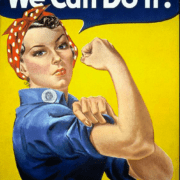Rosie The Riveter – The Jewish Connection
By NC Nelson Mellitz
At the start of World War II, U.S. labor leaders recognized there would be a great shortage of labor needed to meet the demand for production of war materials. While American men served overseas, womens support of the war effort was essential, and the most striking image advocating for women to join the war effort was Rosie the Riveter.
The Rosie of Norman Rockwell’s 1943 painting “Rosie the Riveter” has become a well-known symbol of women strength. That painting later became a poster, often accompanied by the statement, “We Can Do It!” Rockwell’s Rosie is a statuesque and powerful woman. Rosie is wearing denim coveralls and safety equipment used in her dangerous work. In real life, “Rosies” worked day and night shifts to meet the war needs and goals established by the generally male industrial plant supervisors and managers. Almost every civilian at the time knew a real-life Rosie and could identify with her commitment in manning the production lines.
Rockwell considered the Rosie in his portrait an idealized female war worker, painting her with bright red hair, carrying a heavy lunch pail while flexing her muscles. In 1943, the “Saturday Evening Post” magazine used the Rockwell painting on its cover. That solidified Rosie as a domestic icon in many American homes. Production effectiveness studies performed in 1943 and 1944 are often compared to after the war studies in 1946 and 1947 and they show that “Rosie/women were more productive than male counterparts in spite of her smaller stature.” “That little frail can do/More than a male can do.” However, after World War II, “Rosies” were told to return home, and men returning from the war replaced them on the production line. Thousands of women resisted, and by doing, may have led to the start of the second wave of the feminist movement.
Americans were reluctant to take sides in World War II until after the attack on Pearl Harbor on December 7, 1941. Jewish Americans were less likely to be isolationist, especially as news of Nazi atrocities became public. After Pearl Harbor, popular culture focused on winning the war and women were encouraged to abandon the domestic roles and get to work in factories, mostly in manufacturing munitions and other supplies crucial to sustaining the war.
Jacob Moritz Loeb was a prominent Jewish businessman and philanthropist in Chicago. Loeb was a founder of the Chicago Hebrew Institute and served as vice-president of the Jewish Welfare Board (JWB), an organization that has met the needs of Jewish service members and veterans since the start of World War I and continuing today. His son, John Jacob Loeb, was an up-and-coming song writer and wrote “Rosie the Riveter’s” with his partner Redd Evans in 1942, which has an upbeat melody and lyrics. The Rosie the Riveter’s song would have been an unquestionable top 10 hit, if they had such a best seller listing at the time.
The Rosie the Riveter melody and lyrics does not reflect the fear American Jews and others had felt of Naziism, especially compared to the dire wartime works of Jewish artists like Ben Shahn and Arthur Szyk. Loeb made his depiction of Rosie in song lighthearted, but she is still out to crush the Axis. After the war, John Jacob Loeb continued to write songs, often co-authored with Carmen Lombardo, including “Seems Like Old Times” in 1945, which was revived by Diane Keaton in Woody Allen’s “Annie Hall.”
Rosie never retired in the minds of many Americans old and young. Today, when Rosie the Riveter is mentioned and her iconic picture is shown, it evokes an emotional recall to an era when Americans were fighting to preserve freedom and women were carving out a new role in the U.S. industrial factories. When Norman Rockwell decided to name his painting after Loeb and Evans song “Rosie the Riveter,” it was a tribute to the tough working girl.
Volume 77. Number 2. 2023




